1
The following excerpt from a letter written some years ago to The Southern Manitoba Review
1900
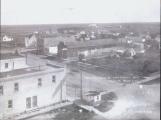
2
The following excerpt from a letter written some years ago to The Southern Manitoba Review, by the late A. E. Steel gives a good description of life in the early days.
3
Before T. S. Menarey opened up his store
1900
Cartwright, Manitoba, Canada
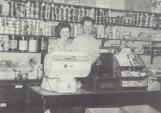
4
Before T. S. Menarey opened up his store at Cartwright, settlers had to go to Emerson for their own supplies. Our nearest neighbor told me that the family was without flour for six weeks and they lived on potatoes all that time. They had milk and meat but no bread. Prairie chickens were abundant and they would trap them alive in a sort of cage-like trap have known of settlers that had to boil wheat al make porridge with shorts until they would be able get a fresh supply of flour. Eventually Coulthard Bros. built a small flour mill at Clearwater and if the wheat was not frozen. they made very fair flour, but if the wheat was badly frozen it was out of the question to get good bread from the flour. In the early days bachelors made what was called bannocks in fact you would see bannocks in most homes those day: Baking powder was used instead of yeast and the frying pan was used more than the oven.
5
Freight for the store
1885
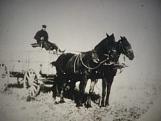
6
I remember being in T. S. Menarey's store on day when Joe Lawrence of Clearwater happened to be unloading a wagon load of freight for the store and I heard him ask a man how much land he hal broken and put into crop. The answer was five acres. The amount would seem to be ridiculously small, but in those days you did not get much land broken up in the first couple of years. A yoke of oxen and a l2-inch breaking plow was slow going and the fresh broken land took a lot of harrowing with three small sections of a harrow; the grain of course was sown by hand. A team of oxen would harrow six acres twice in a day. Our first crop, consisting of five acres of oats, was cut with the cradle and bound by hand. The following year we had a few acres of wheat and some barley. Crawford McKibbin cut the wheat for us with the first self-binder that came into these parts (a Massey or Toronto) and the job done was first class. I can remember Crawford stopping the horses and getting off the binder to show me how to set up the sheaves in long stooks. We didn't make round stooks then.
7
Stooking
1886
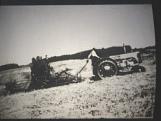
8
Afterward father and a neighbor (Jimmy Bisset) bought a reaper between them so we had all the grain to bind by hand. Jimmy had done a lot of binding in Scotland and was an expert at it. He showed me how to make a band with the straw and the way to handle the sheaf to bind it, and in a short time I could hold my own with him. Although not as young as I used to be, I think I can bind a sheaf as quick as the average stooker.
9
Threshing
1890
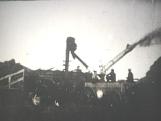
10
I'm just thinking of the great changes that have taken place in the threshing and marketing of the grain. The first threshing outfits were small and the separator was fed by hand from one side; a band-cutter cut the bands of the sheaves with a sharp knife and moved them over to the man feeding the separator, and the straw was built into a stack as it left the straw carriers. The threshed grain ran into bushel measures and was emptied into cotton grain bags, then the grain was hauled away to the granary and the bags emptied. The threshing gang was made up as follows: two feeders, one band-cutter, two on the grain stack, two on the straw stack, one handling the bushel measures and another holding the bags; one hauling the grain away and another running the engine which burned wood, and yet another man to haul water for the engine.
11
Threshing Gang
1890
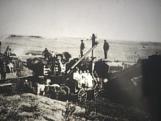
12
What a contrast to the modem threshing outfit made up as follows: two tractors, one sweep taking the stooks to the separator and four men, and threshing three times as much in a day. No filling and emptying bags, no tallying to do. In the days gone by, one threshing outfit would thresh out several districts; now there is an outfit on about every other farm. Changes have certainly taken place; labor saving devices are many. The outfit that threshed in this district one year (I think it was a little over thirty years ago), consisted of a large steam engine and separator, a caboose, a cook car. By the way, Dick Vesey was the cook. There were nine stook teams and nine teams hauling the grain to the granary and to the elevator. If I'm not mistaken there were three men in the field helping to load the sheaves, two spike pitchers helping to unload at the machine, one man running the engine and another feeding it straw. A separator man and a tank man made up the crew. That counted up to nineteen teams and twenty-eight men. The owner of the outfit paid for all the stook teams and all the men that went with the outfit. He boarded his own men and the farmer paid him for boarding the men that hauled away the threshed grain. Threshing started as soon as it was light enough in the morning and stopped at dusk; they stopped for dinner at eleven o'clock. They threshed 2,484 bushels of oats for me one morning and two of us emptied it into the granary from bags. We had no idle moments.
13
Train Station
1912

14
Before we got the railroad there was no market for our grain. What we had to dispose of after supplying our own needs was usually sold for seed to newcomers. After the railroad went through to Deloraine, grain merchants built grain warehouses at Cartwright and Holmfield and had men buying for them. The farmer had to fan his wheat and put it in bags and tie them, then when he got to the warehouse he unloaded on to a portable scale 8 or 10 bags at one time. After the grain was weighed it was emptied into a bin. The grades of wheat at that time were No.1 hard, No.2 and No.3; No.1, No.2 and No.3 frosted. A buyer would get on the wagon or sleigh, open a bag of wheat, examine the grain and make you an offer for it; another buyer would look at it and he would maybe offer you a cent more; we have sold No. I wheat for forty cents per bushel and have sold frosted wheat for twenty-three cents per bushel.